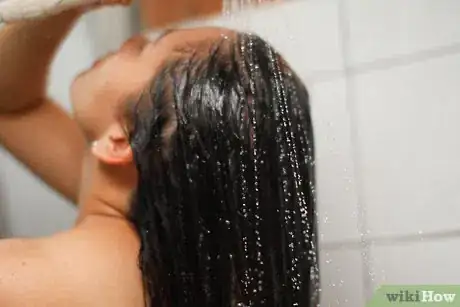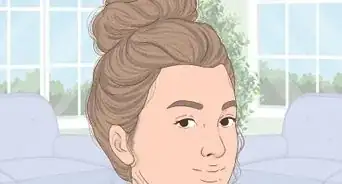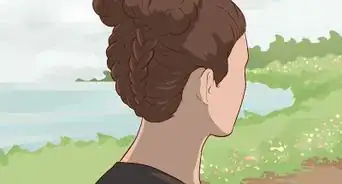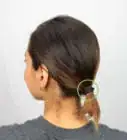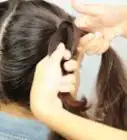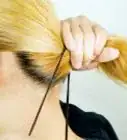This article was co-authored by Ashley Adams. Ashley Adams is a Licensed Cosmetologist and Hair Stylist in Illinois. She completed her Cosmetology education at John Amico School of Hair Design in 2016.
wikiHow marks an article as reader-approved once it receives enough positive feedback. This article received 23 testimonials and 90% of readers who voted found it helpful, earning it our reader-approved status.
This article has been viewed 1,145,605 times.
Bantu* knots are a cute, flirty style traditionally sported by African woman of certain cultural groups and some women of African descent. However, these knots work well with just about all hair types. They are not actually knots! Instead, they are small, coiled buns secured against the side of the head. Regardless, if you uncoil your Bantu knots after you've sported them, you can create a second, curly hairstyle known as a Bantu knot-out.
- the use of the word "Bantu" in this article is not intended to cause any harm. We apologize for any of those who are offended by the term.
Steps
Preparing Hair
-
1Shampoo the hair with a sulfate-free shampoo. Your scalp needs to be very clean since Bantu knots leave a large portion of it exposed. If you have too much product buildup, grime, and flaky skin on your scalp, the style can become itchy and lose some of its glamour.
- You do not need to use any special shampoo for this task, but using a sulfate-free option will help reduce frizz. Simply use the same hair care products you always use when shampooing your hair.
-
2Use conditioner, especially if your hair tends to frizz. If your hair is prone to frizziness or flyaway strands, using a conditioner can help prevent some of this effect. You can opt for either a rinse-out conditioner or a leave-in conditioner.
- A rinse-out conditioner is recommended if your hair dries out easily but is not notably prone to flyaway strands, while a leave-in conditioner is recommended if the hair gets especially dry and frizzy when you work with it.
- Conditioner offers a layer of protection for your hair, which can help prevent breakage as you coil, twist, and wrap it into knots.
Advertisement -
3Detangle your hair, if necessary. If your hair tangles easily, you should brush it using a special detangler brush or comb. For curly or textured hair, opt for a wide-toothed comb, and detangle it while conditioner is still on your hair. Consider applying a detangler serum, as well.
- This may not be necessary if hair is already very stretched-out or relatively tangle-free.
- Detangling the hair help make knots and knot-outs as smooth and shiny as possible when all is said and done.[1]
-
4Dry the hair partially, leaving it damp. There are conflicting opinions concerning whether to work with wet, damp, or dry hair, but the general consensus is that damp hair is best for setting both knots and knot-outs.[2]
- Dry hair tends to be more difficult to set, and the knots or knot-outs may not hold well if you have straight or kinky hair that tends to lose a curl after a few hours.
- Dripping wet hair will not dry while knotted, however, and the knots or knot-outs may become limp as a result of being over-saturated.
- As a general rule of thumb, aim for towel-dry hair that is still damp to the touch but no longer wet enough to wring moisture out of.
Forming the Bantu Knots
-
1Separate the hair into multiple sections. The exact width will vary depending on how short or long the hair is, as well as the look you want to go for if you plan to do knot-outs. Typically speaking, if the hair is short, you should use smaller sections, while women with long hair can opt for larger sections. Typically, the bigger the section the bigger the curls.[3]
- A Rattail comb is usually the best tool to use when separating your hair. Work with the end of the comb to divide your hair into even, clearly divided sections. If you plan to wear your hair as a Bantu knot-out, your parts can be a bit messy, as they won't be noticeable once you take your hair down. However, it's best to create clean parts if you're going to wear the knots.
- If you have shorter hair, keep the sections about 1/2 inch (1.25 cm) wide or smaller.
- If you have longer hair, you can create sections that are roughly 3 to 4 inches (7.6 to 10 cm) wide.
- If you plan to create knot-outs, consider the final texture of the curls you will create when determining the width of your sections. For wavy hair, use medium to large knots ranging from 1 1/2 to 3 inches (3.8 to 7.6 cm) wide. For more defined curls, use small knots that are roughly 1 to 2 inches (2.5 to 4 cm) wide.
-
2Apply a curl cream or similar setting product. Stick with a product that has light to medium hold to create knots and knot-outs that hold their form without becoming stiff. Using your fingers or a styling comb, work the product into your hair, evenly coating your entire length of hair.
- Rub the styling product onto your fingers and twist each section of hair in between your fingers, starting from the roots and working down. This allows you to apply the product while forming a beginning "rope" of hair to build upon for knot.
- Note that you will need to keep the tension of the twist fairly high to maintain the shape.
-
3Twist a small coil at the base of your scalp. Twist each section of hair for a few turns in between your fingertips, as though screwing in a screw or turning a doorknob. Only wind the the hair enough to create a short spring-like coil against your scalp.[4]
- Do not twist your hair up completely in this manner. Twisting a small coil into your hair should be fine, but twisting the entire section into a knot can cause major breakage.
-
4Wrap the rest of the hair around this section. Gradually wind the remaining hair in the section around the base coil, bringing the hair closer to your head with each wrapped layer.
- When working with longer hair, the knots will take on a pyramid or funnel shape. When working with shorter hair, the knots will look more like rosebuds or baguettes.
- The end of each section must be as close to your head as possible in order to hold the knot in place more effectively.
-
5Set the coils in place. If the coils are tight enough, you can usually tuck the ends under the coil to hold them in place. If the coils feel a little too loose, try to retwist them to make them tighter. If this doesn't work, you can use hair pins or small elastic ponytail holders to hold the end of the knots in place.
- If you have naturally curly or kinky hair, you can usually tuck the ends underneath and have success. If your hair is fairly straight, however, you will probably need to rely on hair pins or elastic ponytail holders.
-
6Repeat the knotting procedure on the remaining sections. Each section of hair needs to be twisted into a small coil. Wrap the remainder of each section around its corresponding coil and tuck or pin the ends in place.
- Note that you should also apply the same styling product to each section before beginning to twist and wrap the knots in place.
- If the hair starts to dry out as you work, you can lightly mist it with water from a spray bottle to keep it damp.
-
7Wear your Bantu knots proudly. Bantu knots can be sported as their own style. At this point, the Bantu knots themselves are complete, so you can wear them around town as you please.
- If you let your knots down after they set, however, you can form a curly hairstyle known as Bantu knot-outs.
Doing a Knot-Out
-
1Place a shower cap over your head overnight. If you plan to do a knot-out, it is recommended that you let the hair air dry on its own. Placing a shower cap over the Bantu knots overnight can create a humid, steamy environment for your hair, though, which can help set the style naturally.
- Using a shower cap creates a type of "greenhouse effect," allowing your hair to dry as slowly as possible while retaining enough moisture to prevent them from losing form.
- After you remove the shower cap, your hair will still feel slightly damp. Let it continue air drying for about 15 minutes before pressing forward.
-
2Dry your hair under a bonnet dryer, as an alternative. If you need to set and dry your hair in a hurry, the next best option is to sit under a bonnet dryer and let your hair dry under the warm, steady heat for 30 to 60 minutes.
- Keep in mind that you will likely need about an hour for your hair to dry. Long or thick hair may take even longer to dry. It's normal for your roots to stay damp, as the hair is coiled around them.
- Do not blow dry knots. This will cause them to become far too frizzy when you take them down.
-
3Carefully unwrap each coil. Unpin and unwrap each knot. You should expect to see tight, twisted coils of hair after this step.
- As you work with your hair while taking it down, it is recommended that you apply an oil or anti-humidity serum to your hands. Doing so prevents friction from hands from causing your hair to become frizzy.
- The knots should be unscrewed gently as though you are unscrewing a cap. Do not pull the knot apart.
-
4Loosen the twists gradually. Gently separate each curl using your fingers. To minimize frizzing, you can gently finger-comb a little more styling product into the hair as you loosen the twists.
- You could also use a wide-toothed comb instead of your fingers.
- Avoid playing with the twists too much, though. If you handle your hair too much at this point, it can become frizzy rather easily.
- Avoid pulling each section apart. Instead, you need to lightly "fluff" the hair, arranging it so that the curls look natural and your scalp is no longer visible.
-
5Mist with hairspray or a similar product, if needed. A light mist of hairspray or oil can help prevent flyaway hair while giving your hair a subtle, healthy-looking shine.
- At this point, the Bantu knot-out is ready to sport around town.
-
6Preserve your curls at night. At night, you should pin your hair up and wrap the sides with a scarf. When you wake up in the morning, unpin your hair and re-style the curls gently using your fingers.
- Use a satin scarf, bonnet, or wrap at night for best results.
- You should also sleep on a satin pillow to avoid damaging your hair as much as possible.
- If you want to maintain the look for one or two weeks, clean your scalp with witch hazel or another astringent every three or four days while following this procedure at night to keep your curls looking great.
Expert Q&A
-
QuestionHow long can you leave Bantu knots in?
 Ashley AdamsAshley Adams is a Licensed Cosmetologist and Hair Stylist in Illinois. She completed her Cosmetology education at John Amico School of Hair Design in 2016.
Ashley AdamsAshley Adams is a Licensed Cosmetologist and Hair Stylist in Illinois. She completed her Cosmetology education at John Amico School of Hair Design in 2016.
Professional Hair Stylist You can wear your Bantu knots as a style for up to 2 weeks at a time. After you take them down, you can wear your knot-out curls as a style, as well.
You can wear your Bantu knots as a style for up to 2 weeks at a time. After you take them down, you can wear your knot-out curls as a style, as well. -
QuestionHow can I keep the Bantu knots for a long time?
 Ashley AdamsAshley Adams is a Licensed Cosmetologist and Hair Stylist in Illinois. She completed her Cosmetology education at John Amico School of Hair Design in 2016.
Ashley AdamsAshley Adams is a Licensed Cosmetologist and Hair Stylist in Illinois. She completed her Cosmetology education at John Amico School of Hair Design in 2016.
Professional Hair Stylist The longest you can wear your Bantu knots is for about 2 weeks. You can keep your style fresh by covering your head with a silk scarf while you sleep. After about 2 weeks, you should restyle your hair, or else it will likely look messy.
The longest you can wear your Bantu knots is for about 2 weeks. You can keep your style fresh by covering your head with a silk scarf while you sleep. After about 2 weeks, you should restyle your hair, or else it will likely look messy. -
QuestionDoes this cause lice, since it's wet/damp hair?
 Community AnswerNo. It dries just like normal. You get lice from being near lice, not by having wet hair.
Community AnswerNo. It dries just like normal. You get lice from being near lice, not by having wet hair.
Things You'll Need
- Shampoo
- Conditioner
- Detangling comb or serum
- Rattail comb
- Curl cream or similar styling product
- Hair pins or small elastic ponytail holders
- Shower cap or bonnet dryer
- Hair spray or oil
- Satin scarf
- Satin pillow
References
- ↑ http://www.curlynikki.com/2012/09/how-to-bantu-knot-natural-hair-styles.html
- ↑ http://www.curlynikki.com/2012/09/how-to-bantu-knot-natural-hair-styles.html
- ↑ http://www.perfectlocks.com/blog/how-to-create-Bantu-knots-Bantu-knot-outs/
- ↑ https://www.perfectlocks.com/blogs/all-tressed-up/135495495-how-to-create-bantu-knots-bantu-knot-outs
- Videos provided by Bianca Charisma
About This Article
If you want to make Bantu knots, start by washing your hair, applying conditioner, and brushing it to detangle. Then, use a rattail comb to separate your hair into sections before twisting each section and applying a curl cream. Next, make small coils of hair at your scalp from each section before twisting the rest of your hair around the coil. If your coils are tight enough, tuck the ends of your hair underneath to hold them in place. Alternatively, use hair pins to stop the coils from falling out. To learn how to do a knot-out, read on!

